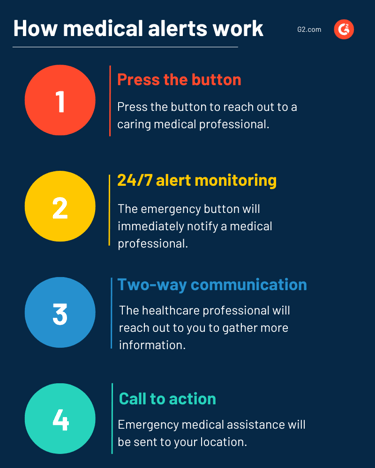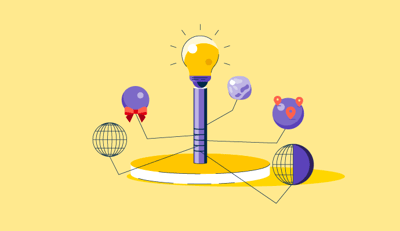October 20, 2023
.png?width=400&height=150&name=Untitled%20design%20(56).png) by Devyani Mehta / October 20, 2023
by Devyani Mehta / October 20, 2023

The worry of a medical crisis is understandable, but for those of us who care for elderly or disabled people, a medical alert bracelet or other emergency medical services becomes a lifeline.
A medical alert system is a wearable or in-home device that monitors the owner and calls the appropriate services if they get hurt or have an immediate medical need.
But before opting for a medical alert system, understand how they work, the costs involved, and the key features worth considering.
Medical alerts protect the safety and well-being of the disabled, the elderly, or those with certain medical conditions. They blend technology and human intervention to create a safety net in times of need.

Pressing the help button triggers the beginning of a series of steps intended to make sure your loved one is safe and healthy. Once the help button is activated, a monitoring center staffed by emergency professionals receives a notification. It dispenses essential information like the user's identity, medical documents, and exact current location, which is determined through GPS tracking.
A key feature of many modern medical alert systems is two-way communication. Monitoring services professionals can directly communicate with the user, evaluate the situation, and comfort them while deciding on the best course of action. Whether a minor incident or an emergency, the staff is prepared to guide the unwell user and offer assistance until help arrives.
Based on the assessment, the monitoring center contacts the appropriate emergency services. This could involve sending paramedics, firefighters, or law enforcement. The center shares the user's medical records and pre-existing conditions with the responders to ensure they can provide effective assistance.
Medical alert systems cater to people of different ages and abilities, seeking extra safety and peace of mind. These systems provide essential support in various circumstances:
Nevertheless, it's worth noting that medical alert devices are only sometimes suitable. They might not be the best option if a person:
of US adults say they or their care recipients use a medical alert system.
Source: Forbes Health
Medical alert systems have advanced significantly since Wilhelm Hormann introduced the idea of home safety for seniors in the early 1970s with ALERT-1.
Hormann's concept, known as Hausnotruf, or literally “home emergency call,” was originally designed for data sharing in the medical field but quickly transformed into home protection for individuals needing assistance.
In 1975, the American International Telephone Company improved on Hormann's idea by creating a wearable necklace and medallion system for seniors. When activated, it sent pre-written distress messages to predetermined phone numbers for help.
Life Alert services, with origins dating back to 1972, envisioned aiding elderly individuals in emergencies, even without access to their phones. This concept blossomed into an industry in the 1980s, popularized by the "I've fallen, and I can't get up!" awareness-raising commercial from 1989.
While these systems changed with technology, limitations persisted in the 1980s and 1990s due to the dearth and limited sophistication of cell phones, tethering seniors to their homes and landlines.
Medical alert systems are a direct line of communication to a dedicated monitoring center. In times of need, they swiftly signal for assistance and promptly connect someone with an emergency contact or the appropriate emergency services. This sophisticated technology offers comprehensive coverage and peace of mind.
.png?width=600&height=375&name=Revenue%20cycle%20management%20vs.%20medical%20billing%20(7).png)
Medical ID bracelets show essential medical information at a glance. They contain vital details such as allergies, medical conditions, and emergency contacts. While invaluable for communicating critical information, their effectiveness is limited when immediate assistance is required, and no one is nearby to see the information on the bracelet.
While medical alert systems and ID bracelets have their merits, it's important to recognize that they offer a more proactive and robust solution in emergency scenarios. However, combining the two can provide a comprehensive approach to personal safety and medical awareness.
Let's delve into the top features of medical alert systems, each of which plays a critical role in enhancing safety and well-being:
In a recent Forbes health survey of 2,000 U.S. adults, key features for modern medical alert systems were identified, where respondents voted for their preferred functionalities.
Activity monitoring and medication reminders (49%) emerged as top choices for proactive health management, while GPS or cellular connectivity (44%) was recognized as crucial for 24/7 assistance. Additionally, 43% emphasized the importance of extras like voice-activated buttons and lock boxes for enhanced accessibility in critical moments.
Numerous medical alert systems cater to unique user requirements. Typically anchored by a compact box that your loved one can conveniently position on a table or nightstand, it takes one press on their wearable to trigger the system.
Although the fundamental principle underpinning the functionality of medical alert systems remains consistent, three distinct types of systems designed to address different situations have emerged:
The first medical alert systems used home setups connected to regular phone lines. They’re still popular among independent, older, or disabled people who want to keep their freedom and feel more comfortable having a landline phone.
These setups include a central base station at home that connects with wearable pendants or wall buttons. When the subscriber presses the button for help, the components work together to inform the medical alert company's call center.
Mobile medical alert systems are valued for their adaptability, presenting choices such as standalone mobile devices and wearable call buttons. These systems adapt to homebound seniors or disabled people and active older adults, ensuring a swift method to seek assistance during emergencies.
GPS devices are pivotal because they use the medical alert company's cellular network or Wi-Fi. While some devices integrate all functions, others feature wearable help buttons.
For simplicity, a lightweight necklace option guarantees convenient access to the help button without any added gadgets. As an additional layer of security, specific GPS devices provide fall detection, often available for an extra fee.
These systems suit those with health issues or mobility challenges, whether alone or in-home support. The base station is placed centrally, and the user wears the help button or places it within reach.
You can choose Landline or cellular as your connection options, similar to cell phones. The cellular choice uses the medical alert company's network without a separate cellular plan. The subscriber has to live in an area with good cellular coverage, though.
Advanced at-home systems have features for caregivers, like medication reminders, motion sensors, and monitors for air quality and temperature to prevent issues like carbon monoxide exposure or extreme indoor temperatures.
Recently, in-vehicle systems came onto the market, thanks to one provider. They use a portable device that plugs into a car's 12-volt adapter for power, with a backup battery life if needed.
Like mobile systems, in-vehicle alerts use cellular networks. They have crash detection and GPS for accurate location in emergencies. The devices have a built-in speaker, microphone, and instant-connect button to link to the provider's call center.
The systems can be further categorized into two distinct types: monitored and unmonitored.
This involves a dedicated monitoring center staffed by agents who actively supervise emergency calls and swiftly evaluate situations. When deemed necessary, they initiate responses, like contacting 911 or designated emergency contacts.
Monitored systems come with a monthly fee, but they offer a comprehensive range of benefits and features compared to their unmonitored counterparts.
This version doesn’t interface with a monitoring center. Instead, they connect with 911 or predetermined emergency contacts. This system provides a more direct communication path during emergencies.
Using a medical alert system is a simple process, and all these systems follow a similar procedure.
You have multiple options available to you:
Starting with the company's website or contacting them directly is recommended. This way, you learn how to customize a system that meets your needs.
A single press of a button initiates a call to a response center. This function is activated whether you're using an in-home console or a mobile device, such as a pendant, wristband, or pocket unit.
Once the call is connected, an operator at the response center engages in a two-way conversation with your loved one. If communication cannot be established or there’s no response, the operator will quickly dispatch local emergency services to the location.
The operator talks to your loved one to assess their specific needs. Trained to handle various emergencies, operators stay on the line until help arrives.
Your loved one and the operator determine the necessary assistance based on the requirements. This might involve contacting someone from your emergency contact list or calling local emergency services.
Choosing the appropriate medical alert system calls for a thorough evaluation of the subscriber’s capabilities, both in the present and for the foreseeable future.
Be sure to keep a few things in mind when you start your quest for a medical alert system:
Getting a free or cheaper medical alert system depends on your assets and what your insurance covers:
The best medical alert system grants numerous benefits, especially for disabled or elderly people.
While medical alerts can provide valuable assistance in emergency situations, don’t gloss over these potential downfalls.
As technology advances, medical alert systems continue to improve lives and healthcare experiences. This article highlights the various options, from wearables to home-based setups with features like fall detection and GPS. It's worth noting that while these systems provide immediate help, they should complement regular medical care rather than replace it.
Now that you have a better understanding of medical alert systems and their role in ensuring the safety of your loved ones consider bookmarking this article for future reference. This way, you'll have a handy guide available whenever you need to choose the right system to protect your family.
Discover more about healthcare analytics and the advantages of using data to enhance your well-being.
Devyani Mehta is a content marketing specialist at G2. She has worked with several SaaS startups in India, which has helped her gain diverse industry experience. At G2, she shares her insights on complex cybersecurity concepts like web application firewalls, RASP, and SSPM. Outside work, she enjoys traveling, cafe hopping, and volunteering in the education sector. Connect with her on LinkedIn.
While unboxing a new shampoo tailored specifically for Indian hair types, I couldn't help but...
.png) by Devyani Mehta
by Devyani Mehta
In today's crowded market, countless products launch daily, but only a few succeed while the...
.png) by Devyani Mehta
by Devyani Mehta
I was just about to use a skincare product sent by a brand when I received a call from...
.png) by Devyani Mehta
by Devyani Mehta
While unboxing a new shampoo tailored specifically for Indian hair types, I couldn't help but...
.png) by Devyani Mehta
by Devyani Mehta
In today's crowded market, countless products launch daily, but only a few succeed while the...
.png) by Devyani Mehta
by Devyani Mehta


